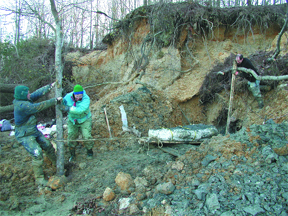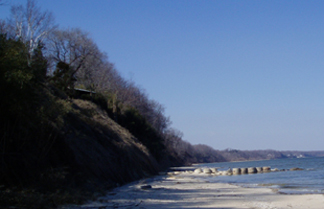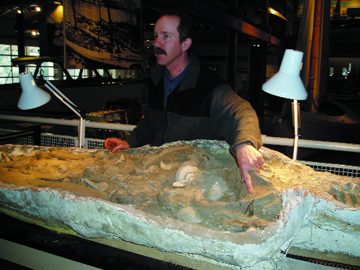 Last September,
Hurricane Isabel ravaged the U.S. East Coast, upending trees, flooding cities,
killing people and leaving millions without power. In its devastating, furious
race up the coast, the hurricane did one positive thing: It unearthed an extremely
rare 8-million-year-old whale skeleton.
Last September,
Hurricane Isabel ravaged the U.S. East Coast, upending trees, flooding cities,
killing people and leaving millions without power. In its devastating, furious
race up the coast, the hurricane did one positive thing: It unearthed an extremely
rare 8-million-year-old whale skeleton. Calvert Marine Museum paleontologists pull an 8-million-year-old whale skeleton from its resting place in the Calvert Cliffs off the Chesapeake Bay in Maryland. The whale skeleton was unearthed by Hurricane Isabel in September 2003 and discovered by amateur fossil hunters. Photo courtesy of Calvert Marine Museum.
Amateur fossil hunters found the 5.5-foot-long skull and other fossilized bones along a stretch of cliffs in Maryland that is well-known for its plethora of Miocene fossils. After extensive excavation, including a military-airlift rescue of the fossil, the complete skull now resides in the Calvert Marine Museum, on the Chesapeake Bay in Solomons, Md., where paleontologists and volunteers are painstakingly cleaning it on the main museum floor.
 The Calvert
Cliffs extend for 30 miles along the western shore of the Chesapeake Bay. The
cliffs, which sometimes reach as high as 100 feet, are the most complete sequence
of marine sediments exposed on the East Coast. They exhibit three distinct Miocene
(23.8 to 5.3 million years ago) formations filled with fossil shells and shark
teeth, as well as fossilized whale, dolphin and, occasionally, bird and land
mammal bones. The sandy cliffs erode 1 to 2 feet each year due to landslides,
waves and storms, which is why, when Isabel hit, Jeff DiMeglio and Sarah Gulick
of Alexandria, Va., headed to the cliffs to hunt for fossils.
The Calvert
Cliffs extend for 30 miles along the western shore of the Chesapeake Bay. The
cliffs, which sometimes reach as high as 100 feet, are the most complete sequence
of marine sediments exposed on the East Coast. They exhibit three distinct Miocene
(23.8 to 5.3 million years ago) formations filled with fossil shells and shark
teeth, as well as fossilized whale, dolphin and, occasionally, bird and land
mammal bones. The sandy cliffs erode 1 to 2 feet each year due to landslides,
waves and storms, which is why, when Isabel hit, Jeff DiMeglio and Sarah Gulick
of Alexandria, Va., headed to the cliffs to hunt for fossils.The soft Miocene soils along Calvert Cliffs on Maryland’s coast provide a rare fossil-viewing opportunity. Photo by Megan Sever.
The fossil collectors first saw a large rib bone poking out of the base of the cliff, says Stephen Godfrey, curator of paleontology at the museum. Closer inspection revealed the front end of both lower jawbones as well. Guessing that they had found something important, DiMeglio and Gulick called the museum.
When DiMeglio returned to the site with Godfrey, they found a complete whale skull with both upper and lower jaws intact, even though the skeleton was upside down. In addition to the skull, they found articulated neck vertebrae, a scapula, ribs scattered throughout the area amidst many mollusk fossils and several shark teeth.
“I knew we had something big,” Godfrey says excitedly. “But before we could excavate, we had to obtain permission from the family that owns the land.” This negotiation took nearly two months because the extended family of the landowners wanted to be there when geologists started to quarry. “They were excited too,” Godfrey says.
For two weeks, Godfrey and a team from the marine museum dug down around the skeleton before encasing it in a “field jacket” — a rigid, multilayer carrying case made of burlap, plaster and wood and metal splints — to transport the fossil safely. However, once completed, the jacketed fossil weighed 1,000 pounds. Godfrey quickly realized that normal transportation would not suffice: The remote cliff location meant no truck could reach it; the shallow bay water precluded any large boat picking it up; and the skeleton would have sunk any small boat. Thinking back to his dinosaur-excavating days in Alberta, Canada, Godfrey decided to call on the military for air support.
Godfrey called the nearby Naval Air Station Patuxent River to see if “an 8-million-year-old whale would pique their interest enough to help” — and it did. On Dec. 16, 2003, a UH-3H Sea King helicopter with its search-and-rescue team plucked the whale skull off the beach and flew it to safety, just as they would a downed aircraft pilot.
In January, the skeleton went on public display in the middle of the museum’s main floor. Since then, volunteers have been working every day to clean the fossil. They answer questions from curious visitors and explain the excavation process, while they meticulously scrape the sand and silty sediments away from the shells and bones in the plaster jacket with old dental tools. Once the volunteers finish clearing the upper side of the skull, they will make a cradle and flip the skull over to remove the rest of the field jacket and entombing dirt, Godfrey says, all in the public eye.
“Showing the public how paleontology — at least part of it — is done is great,” says Warren Allmon, director of the Paleontological Research Institute in Ithaca, N.Y. Over the past few years, volunteers have been excavating a mastodon on the institute’s floor. “People came out in droves and loved looking at the excavation and talking about the process,” Allmon says. Using volunteers in the research and excavation process is doubly beneficial for the public, he says, in that the scientists educate people, both young and old, who then pass on their knowledge to the wider public.
“Watching people prepare fossils is neat,” agrees Mark Uhen, curator of paleontology and zoology at the Cranbrook Institute of Science in Michigan. The Cranbrook Institute has requested a grant to build a paleontology “prep lab,” something most museums have. “Showing the process of science is extremely beneficial for students and the public,” and can serve to excite people about science, Uhen says.
The Maryland whale has excited people both locally and beyond, Godfrey says — from the people on whose land the fossil was found, to the people flocking to see the live excavation. The national press coverage of the whale discovery and excavation has put the locally known museum on the national map.
School groups are welcome at this kid-friendly museum. And at several public beaches along Calvert Cliffs, adventurous visitors can beach-comb for fossils to their heart’s content.

 The
8-million-year-old whale, exposed by Hurricane Isabel last September in
cliffs along Maryland’s coast, was 18 to 20 feet long, as its 5.5-foot
skull indicates — making it small by modern standards but fairly
large for the Miocene. Geologists have dated the whale by correlating
fossils found with the skeleton to identical fossils in other formations
of known geologic age.
The
8-million-year-old whale, exposed by Hurricane Isabel last September in
cliffs along Maryland’s coast, was 18 to 20 feet long, as its 5.5-foot
skull indicates — making it small by modern standards but fairly
large for the Miocene. Geologists have dated the whale by correlating
fossils found with the skeleton to identical fossils in other formations
of known geologic age. 